 Cataclysmic Binary stars (cataclysmic variables) are star systems in which a white dwarf star and a companion star are locked in a dance of death; matter drawn from the companion can eventually cause the white dwarf to enter into a state of runaway fusion, leading to a series of recurrent dwarf nova explosions.
Cataclysmic Binary stars (cataclysmic variables) are star systems in which a white dwarf star and a companion star are locked in a dance of death; matter drawn from the companion can eventually cause the white dwarf to enter into a state of runaway fusion, leading to a series of recurrent dwarf nova explosions.
Mark A. Garlick’s space art has all of the explosive promise of the cataclysmic binary stars he used to study as an astronomer at Sussex University in the United Kingdom.
Mark obtained a degree in Astronomy and shortly thereafter a Doctorate in Astrophysics. For a relatively short time he conducted research into the aforementioned cataclysmic binary stars – specifically the Intermediate Polar varieties (a type of cataclysmic variable in which the central region of the white dwarf’s accretion disc has been truncated due to the dwarf’s powerful magnetic field and material from the inner edge of the disc flows, as a curtain of gas, onto the poles of the star) before deciding that the life of a professional astronomer was not for him.
While conducting his research he had also dabbled in painting and writing articles for publications such as Astronomy Now and Modern Astronomer. Given the awe, power and majesty of the astronomical objects he had been studying through a telescope it is easy to see why he was drawn to depicting them.
Having accumulated a fair inventory of articles and the illustrations to go with them, Mark decided upon a career as a writer, illustrator and fine artist of scientifically accurate astronomical objects, dinosaurs and the earth Sciences.
Mark has written and/or illustrated numerous articles for publications such as The Guardian, New Scientist, Scientific Computing World, Astronomy Now, Scientific American, Astronomy and Sky & Telescope and written and illustrated a number of books including Astronomy: A Visual Guide, (Insiders) Atlas of the Universe, and The Story of the Solar System.
In addition to digital illustrations of a variety of astronomical subjects, Mark also dabbles in the realm of science fiction illustration and digital animation, including these eye-popping (and scientifically accurate) animations of –
A Black Hole Binary System
Mars as a Blue Planet (Terraforming Mars)
and a Tour Through Saturn’s Rings (Inside the Rings)
Mark is a Fellow of the International Association of Astronomical Artists and currently accepts commissions, in addition to selling fine art prints of many of his illustrations. Links to his website, galleries and print offerings follow the gallery of Mark’s illustrations.
The descriptions of the following pieces were provided by Mark A. Garlick.
GALLERY

The Desert Runners
Sky and terrain created in Terragen. The rest hand-painted in Photoshop. I found a photo of a woman running and used that as the template for the robot, just tracing over it in Photoshop.
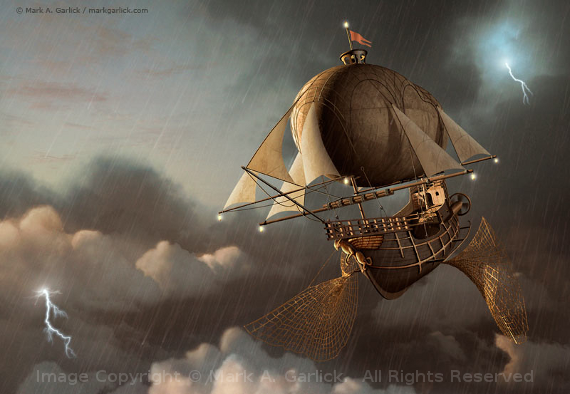
Image Copyright © Mark A. Garlick. All Rights Reserved.
Flight of the Griffin
This was a commission for the cover of an SF novel of the same name. I created the ship in 3DS Max, then composted it onto some clouds in Photoshop. Some of the clouds were from photos while others were added by hand.

Image Copyright © Mark A. Garlick. All Rights Reserved.
The Garland Citadel
This began life as a photo of a cloudscape, taken in Thailand. I brought it into Photoshop and drew over it, adding the landscape, structures and vehicles by hand.
I called it the Garland Citadel because of the long, hanging structures that connect to it from the outskirts.

Image Copyright © Mark A. Garlick. All Rights Reserved.
Giant
This is an image of a massive and very luminous type of star called a blue giant, created for my upcoming book Cosmic Menagerie. These stars are dozens of times the radius of the Sun and thousands of times brighter. I created the landscape in Vue and the rest was done in Photoshop.
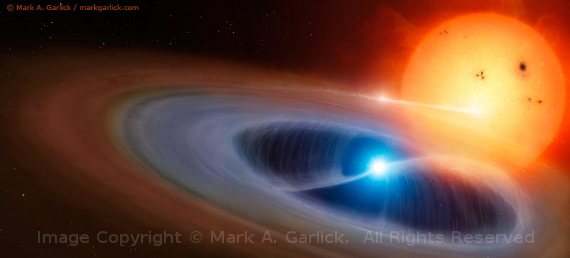
Image Copyright © Mark A. Garlick. All Rights Reserved.
Intermediate Polar
An image commissioned years ago for a scientific conference on magnetic cataclysmic variables, entirely Photoshop. Called CVs for short, these are close binary stars in which a red dwarf orbits a much smaller but more massive stellar corpse called a white dwarf. In one subclass of the CVs, the intermediate polars, the white dwarf has a powerful magnetic field. Its gravity peels gas from the surface of the red dwarf, and this material flows towards and around the white dwarf. Gas on the inner edge of this ring attaches to the magnetic field and flows along it in giant structures called accretion curtains, towards the magnetic poles of the waiting white dwarf.

Image Copyright © Mark A. Garlick. All Rights Reserved.
Invasion
This was a portfolio piece I did years ago. Mostly Photoshop but the figures were done in Poser.
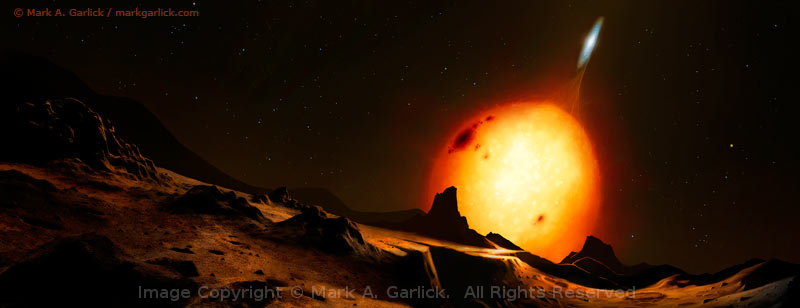
Image Copyright © Mark A. Garlick. All Rights Reserved.
LMXB
Standing for low-mass X-ray binaries, LMXBs are interacting binary stars in which a red dwarf orbits a black hole or a neutron star. The latter is at the top, pulling gas from the red dwarf and distorting its shape. Bits of the landscape are from Vue, but the rest was done in Photoshop.

Image Copyright © Mark A. Garlick. All Rights Reserved.
The Road to Pi
This began of a photo of a field I took one day on a walk in the country. I brought it into Photoshop and totally changed it, adding the structures, ships, planet and creatures by hand. The building looks a bit like the Greek letter pi, which is how the image got its name.

Image Copyright © Mark A. Garlick. All Rights Reserved.
Supergiant
Another image for my upcoming book Cosmic Menagerie, this shows an example of the largest stars known to sciences, red supergiants. These begin as much smaller stars and then expand at the end of their lives before detonating themselves in a supernova explosion. A luckless planet is being destroyed as the star grows to monstrous dimensions.
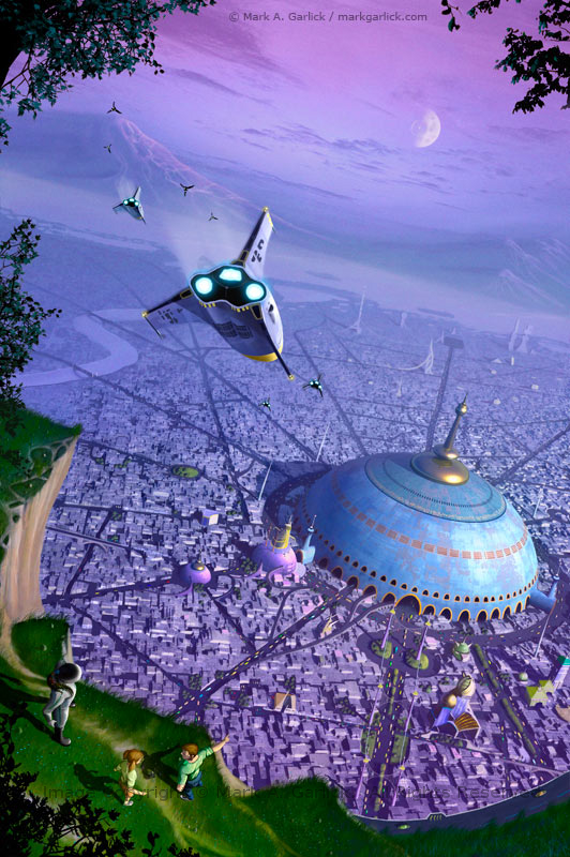
Image Copyright © Mark A. Garlick. All Rights Reserved.
Transit City
This was a cover commission for a novel called Galactic Guardian by fellow space artist Jon Ramer (current president of the International Association of Astronomical Artists). Created using a combination of Bryce, Poser and Photoshop.
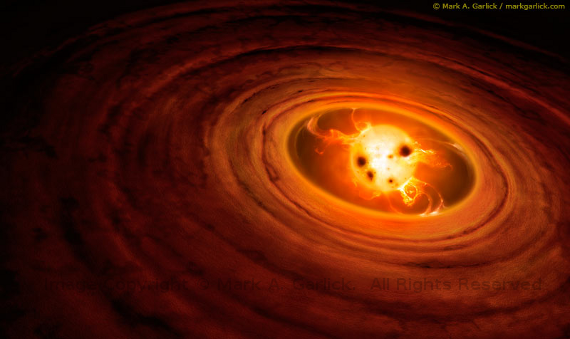
Image Copyright © Mark A. Garlick. All Rights Reserved.
T-Tauri Star
A T-Tauri star is a young stellar object not quite yet a true star. They are shrinking under gravity and warming up, but are not yet hot enough in their cores to generate the nuclear reactions that define true stars. They are usually surrounded by a disc of gaseous material from which the star formed, and from which planets will one day also be created. T-Tauri stars are highly magnetic, so they have huge star spots, dwarfing the sunspots that speckle the surface of the Sun.
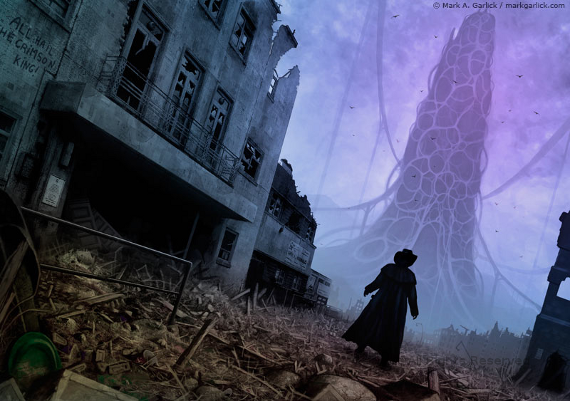
Image Copyright © Mark A. Garlick. All Rights Reserved.
The Waste Lands
I am a big Stephen King fan and I especially love his Dark Tower novels. This was one I did based on book three in the cycle, The Waste Lands. This began as a photo of a gym (still functional, not a derelict!) You can see the gym building on the left. I used Photoshop to dirty up the building and add everything else that you can see. This is one of my favourite SF images.
Mark’s latest book, which he conceived, wrote and illustrated, is called Cosmic Menagerie, and will be released this November, 2013
Mark’s artwork and animations can be found on his primary website MarkGarlick.com.
A listing of the books he has written and/or illustrated can be found here.
Several of his animations can be found on his YouTube Channel
A gallery of his works can be found on the UK Space Art website
And prints are available here (though the site is admittedly in need of updating).






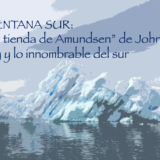



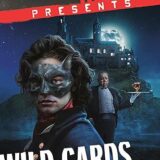
Recent Comments